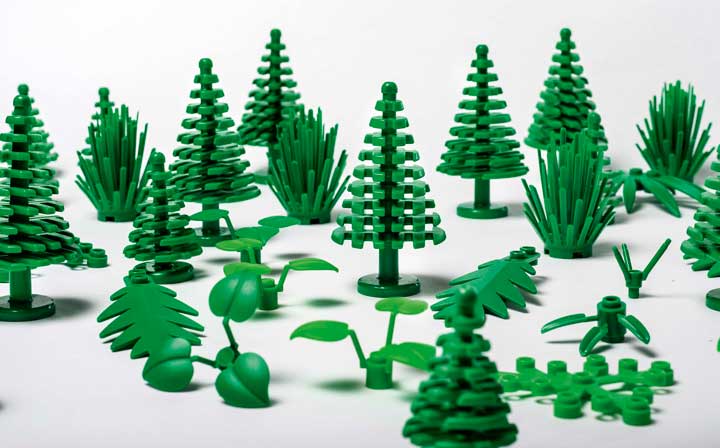LEGO is making moves to build a more sustainable company, one brick at a time. In a statement published March 1, LEGO announced their intent to alter production of their popular toys. Beginning later this year, some of the pieces packaged in their sets will be made from plant-based plastics.
Appropriately enough, the first elements to make the switch will be botanical in nature. The landscaping materials in your sets, things like leaves, bushes, and trees will be molded from plastics sourced from sugarcane.

Tim Brooks, VP of Environmental Responsibility at the LEGO group, said in a statement,
“At the LEGO Group we want to make a positive impact on the world around us, and are working hard to make great play products for children using sustainable materials. We are proud that the first LEGO elements made from sustainably sourced plastic are in production and will be in LEGO boxes this year. This is a great first step in our ambitious commitment of making all LEGO bricks using sustainable materials.”
The long term goal is to switch production of all LEGO bricks to sustainable, plant-based plastics by 2030. Additionally materials like packaging and instruction manuals will switch to sustainable materials as well.
Plastics have been increasingly in the public eye of late. Considering the environmental impact of the material and the swelling Great Pacific Garbage Patch, it’s smart for a company that produces nothing but the stuff, to be thinking about sustainable solutions. But what does it really mean for LEGO, for the environment, and for the consumer?
Traditionally, plastics have been a product of the oil industry. Chemists put crude oil through a cracking process which isolates hydrocarbon monomers. Using various polymerization reactions, those hydrocarbons are transformed into polymers resins, as the name suggests. This produces plastic pellets that can be melted down and formed into whatever shape is necessary for the product in question.
At LEGO, the pellets are heated to 232 degrees Celsius at their factory in Denmark before being molded into the various shapes needed to build Death Stars, dragons, SPACESHIPS!, or whatever the everyday master builder can dream up.
LEGO promises the consumer will notice no difference in their products. The process will remain mostly unchanged, with one major difference. Instead of beginning with crude oil, they will begin with plastic pellets derived from sugar cane.
The process of producing bio-plastics has been ongoing for some years, gaining its biggest foothold in Brazil where there is an already established sugarcane industry. Bio-plastic, also called biopolyethylene, begins life as one of various plants. The plants are used to produce ethanol, a natural alcohol resulting from the fermentation of sugars by yeast. While, ethanol can be found in any natural setting that contains both yeast and sugar, it is produced in large quantities in factories like the one in Brazil.
After being dehydrated, ethanol becomes ethylene with contains the hydrocarbons needed to begin the plastic making process. The result is the same, leaving you with identical plastic pellets without the need of drilling. You’d be unable to pick out a bio-plastic LEGO brick in a lineup.
This is important to LEGO. Their product is so successful specifically because any two bricks can work together. While sets come with instructions for building various structures, it’s the free nature of play that really defines what they do.
And it’s good for the environment, too. At least in some ways. By virtue of having to first grow plants in order to manufacture ethanol and, eventually, biopolyethylene there is some reduction in carbon emissions. If you remember your grade school lessons, you’ll remember that plants take in carbon as part of the process of photosynthesis. While the manufacturing of bioplastics emits carbon, it is offset to some degree by the growing.
It isn’t, however, all green fields and blue skies. Critics are concerned that an increase in demand for bioplastics may result in clear cutting forests for crop land. Additionally, as the end product is identical to traditional plastics, they aren’t biodegradable, something often not made clear to consumers.
What LEGO is doing is a nice gesture and a good first step toward changing the way we interact with the environment in pursuit of the things we want and need but it is only a first step. While switching to plant-based plastics decreases the environmental impact of production on the front end, we all need to take steps to continue the spirit of this initiative on our end.
While LEGO prides themselves on being able to build anything, we should ensure we build a better world, not a bigger garbage patch.